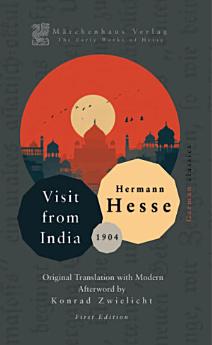Visit from India
The Early Works of Hermann Hesse 42권 · Marchen Press
eBook
199
페이지
family_home
적용 가능
info
report검증되지 않은 평점과 리뷰입니다. 자세히 알아보기
eBook 정보
Visit from India is Hesse’s 1913 travelogue, presented as a collection of notes from his journey through Asia. This is sometimes translated as "From India" or "Visitors from India". This edition also includes his later 1919 reflection "Remembrance of Asia" (Erinnerung an Asien), creating a coherent view of his thought on pan-Asian culture. The text records scenes from his sea voyage (including passing through the Suez Canal) and visits to places like Penang, Singapore, Ceylon and Sumatra. Hesse’s narrative is descriptive and journal-like, alternating vivid sketches of landscapes, city life and local customs with his own thoughts. Critics note that the work explores “themes of culture, landscape, and personal introspection”. In it Hesse invites readers to experience the sights, sounds and sensations of the East and to share the traveler’s impressions of temples, markets and coastal vistas. A section of poems (“Gedichte”) at the end of the volume reflects on scenes from the journey (e.g. the Red Sea, Singapore festival, Colombo). Written just before World War I, Aus Indien reflects early-20th-century German interest in the exotic East and is framed by the colonial context of British and Dutch Asia. Hesse describes architectural contrasts and the mixture of Eastern and European influences in port cities. A notable theme is the contrast between Eastern spiritual life and Western materialism. Hesse later commented that “the whole East breathes religion in a way the West breathes reason and technology”. In the book he observes the pervasive religious atmosphere in Asia – temples, ceremonies and faith in daily life – which he portrays as a source of wonder compared to the mechanistic West. This new edition features a fresh, contemporary translation of Hesse's early works on Asian and Indian culture, making these historic travel and culture commentary accessible to modern readers. Enhanced by an illuminating Afterword focused on Hesse's personal and intellectual relationship with Carl Jung, a concise biography, a glossary of essential philosophical terms integral to his writings (his version of Jungian Psychological concepts) and a detailed chronology of his life and major works, this robust edition introduces the reader to the brilliance of his literature in context. It not only captures the depth and nuance of Hesse’s thought but also highlights its enduring impact on the debates of the mid-20th century, contemporary culture and Western Philosophy across the 20th and into the 21st century.
저자 정보
Herman Hesse (1877-1962) navigated a life shaped by psychological turbulence that fundamentally transformed his literary vision following his pivotal encounter with Carl Jung's analytical psychology. After suffering a severe breakdown in 1916 amid his crumbling first marriage and the ravages of World War I, Hesse underwent intensive psychoanalysis with Jung's student J.B. Lang and later with Jung himself, sessions that would profoundly alter his creative trajectory. This Jungian influence became evident in his subsequent works, particularly "Demian" and "Steppenwolf," where the protagonist's journey toward individuation—Jung's concept of integrating the conscious and unconscious aspects of personality—emerges as a central theme. Hesse's correspondence with Jung continued for decades, their intellectual relationship deepening as Hesse increasingly incorporated Jungian archetypes, dream symbolism, and the notion of the shadow self into his narratives of spiritual seeking. The writer later acknowledged that Jung's therapeutic methods had not only rescued him from psychological collapse but had fundamentally reshaped his understanding of human consciousness, enabling him to transmute his personal suffering into the allegorical quests for wholeness that characterized his most enduring works.RetryClaude can make mistakes. Please double-check responses.
이 eBook 평가
의견을 알려주세요.
읽기 정보
스마트폰 및 태블릿
노트북 및 컴퓨터
컴퓨터의 웹브라우저를 사용하여 Google Play에서 구매한 오디오북을 들을 수 있습니다.
eReader 및 기타 기기
Kobo eReader 등의 eBook 리더기에서 읽으려면 파일을 다운로드하여 기기로 전송해야 합니다. 지원되는 eBook 리더기로 파일을 전송하려면 고객센터에서 자세한 안내를 따르세요.











